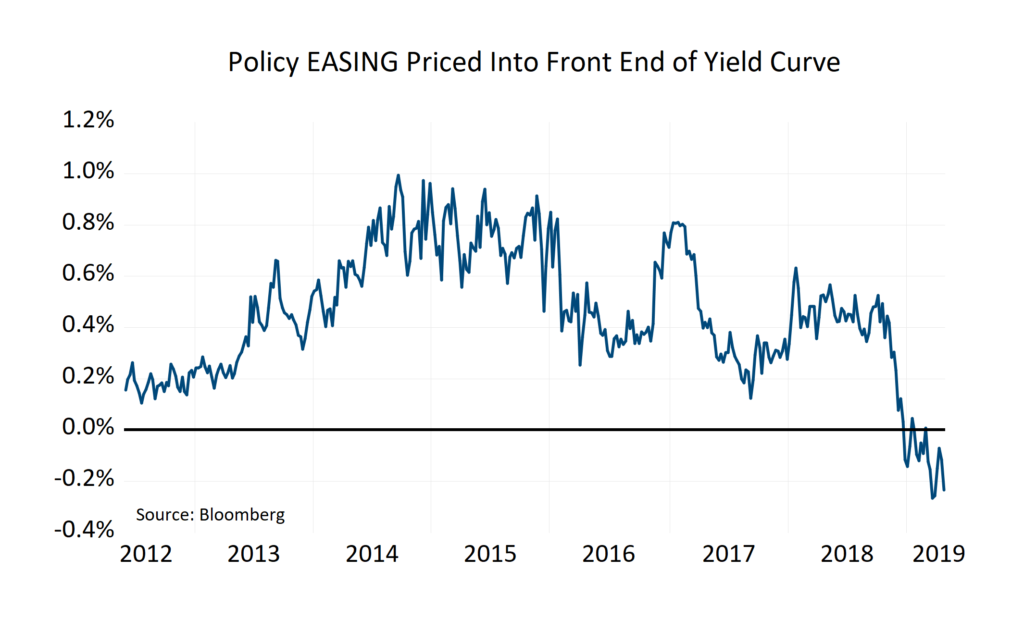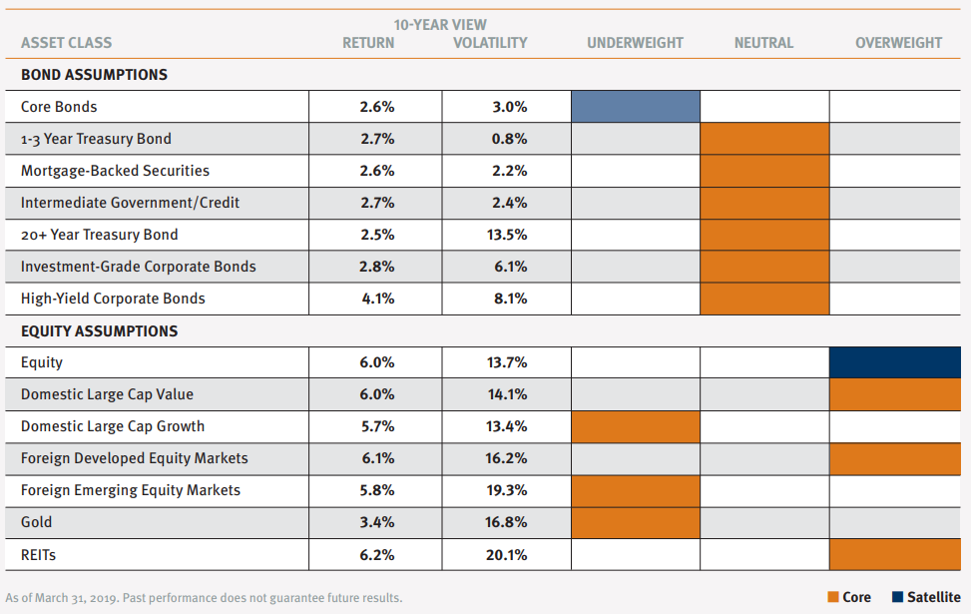A World Without Yield… Still…
France, Germany, Spain, Portugal, Sweden, the Netherlands, Switzerland, and Japan remain stuck with negative short-term (2-year) interest rates. By comparison, at 2.3%, the United States’ two-year Treasury rates seems to be quite a bargain. However, markets are expecting that U.S. rates at the short end of the curve will not be moving higher any time soon, and could even move lower despite relatively strong growth.
An investor today can lock in a rate of 2.16% in the forwards market at which that investor could borrow or lend for one year’s time one year from now. This “forward” rate is below today’s one-year Treasury rate, which is priced to yield 2.28%. The difference between the future and current short-term rate (chart, below) embeds important information about what the market is actually thinking about the risk of changes in monetary policy. In short, the market fully believes that there is no appreciable risk of a Federal Reserve rate hike any time soon. There is no “risk premium” priced into the front end of the curve.

A Nagging Problem
This brings us to a nagging, central problem in our long-term forecasting process. This problem is the absence of yield or risk premia, not only at the front of the curve, but across most of the fixed income universe in general. This absence of nominal yield is made more painful by Treasury Bill and other “cash” rates above 2%. A flat yield curve and tighter credit spreads leaves risk-adjusted, forward-looking returns low and almost indistinguishable across many fixed income assets.
This was not the case in the past. Over the past ten years, risk adjusted returns were significantly different across different segments of the fixed income marketplace. For example, investment grade corporate bonds returned 6.8% annually while long-term Treasuries returned 4.8% with greater risk. Given today’s low starting yields, and our expected return on cash above 2%, we see lower, and more uniform, risk-reward tradeoffs throughout the fixed income spectrum (top half of table, below). Because of this, and with the data suggesting continued progress for the economy, we have adopted a neutral stance with minimal tactical tilts at this time. We note that this is posture will most likely change in the future as market developments and incoming data on the economy warrant.
WCA Long-Run Capital Market Assumptions
April 2019

Source: WCA
Conclusion
The continuation of low rate policies around the world continue to exert a powerful force on global economies and asset values. At some point, this situation will change. For now, we seem to be enjoying the best of all worlds — a powerful wealth effect from years of rising asset values, clear signs of improving growth, and central banks that are acting and behaving in a very market-friendly way.
We invite you to read our latest tactical asset allocation piece where we discuss how we are tactically allocating portfolios from both a long-run and short-term perspective.
Kevin Caron, CFA, Senior Portfolio Manager
Chad Morganlander, Senior Portfolio Manager
Matthew Battipaglia, Portfolio Manager
Steve Lerit, CFA, Client Portfolio Manager
Suzanne Ashley, Analyst
(973) 549-4168
www.washingtoncrossingadvisors.com
www.stifel.com
Disclosures
WCA Fundamental Conditions Barometer Description: We regularly assess changes in fundamental conditions to help guide near-term asset allocation decisions. The analysis incorporates approximately 30 forward-looking indicators in categories ranging from Credit and Capital Markets to U.S. Economic Conditions and Foreign Conditions. From each category of data, we create three diffusion-style sub-indices that measure the trends in the underlying data. Sustained improvement that is spread across a wide variety of observations will produce index readings above 50 (potentially favoring stocks), while readings below 50 would indicate potential deterioration (potentially favoring bonds). The WCA Fundamental Conditions Index combines the three underlying categories into a single summary measure. This measure can be thought of as a “barometer” for changes in fundamental conditions.
The information contained herein has been prepared from sources believed to be reliable but is not guaranteed by us and is not a complete summary or statement of all available data, nor is it considered an offer to buy or sell any securities referred to herein. Opinions expressed are subject to change without notice and do not take into account the particular investment objectives, financial situation, or needs of individual investors. There is no guarantee that the figures or opinions forecasted in this report will be realized or achieved. Employees of Stifel, Nicolaus & Company, Incorporated or its affiliates may, at times, release written or oral commentary, technical analysis, or trading strategies that differ from the opinions expressed within. Past performance is no guarantee of future results. Indices are unmanaged, and you cannot invest directly in an index.
Asset allocation and diversification do not ensure a profit and may not protect against loss. There are special considerations associated with international investing, including the risk of currency fluctuations and political and economic events. Investing in emerging markets may involve greater risk and volatility than investing in more developed countries. Due to their narrow focus, sector-based investments typically exhibit greater volatility. Small company stocks are typically more volatile and carry additional risks, since smaller companies generally are not as well established as larger companies. Property values can fall due to environmental, economic, or other reasons, and changes in interest rates can negatively impact the performance of real estate companies. When investing in bonds, it is important to note that as interest rates rise, bond prices will fall. High-yield bonds have greater credit risk than higher-quality bonds. The risk of loss in trading commodities and futures can be substantial. You should therefore carefully consider whether such trading is suitable for you in light of your financial condition. The high degree of leverage that is often obtainable in commodity trading can work against you as well as for you. The use of leverage can lead to large losses as well as gains.
All investments involve risk, including loss of principal, and there is no guarantee that investment objectives will be met. It is important to review your investment objectives, risk tolerance and liquidity needs before choosing an investment style or manager. Equity investments are subject generally to market, market sector, market liquidity, issuer, and investment style risks, among other factors to varying degrees. Fixed Income investments are subject to market, market liquidity, issuer, investment style, interest rate, credit quality, and call risks, among other factors to varying degrees.
This commentary often expresses opinions about the direction of market, investment sector and other trends. The opinions should not be considered predictions of future results. The information contained in this report is based on sources believed to be reliable, but is not guaranteed and not necessarily complete.
Washington Crossing Advisors LLC is a wholly owned subsidiary and affiliated SEC Registered Investment Adviser of Stifel Financial Corp (NYSE: SF).



